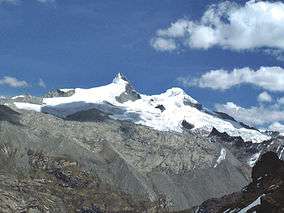Paryaqaqa
| Paryaqaqa | |
|---|---|
| Tulluqutu | |
 The southern and the northern peak of Paryaqaqa | |
| Highest point | |
| Elevation | 5,750 m (18,860 ft) [1] |
| Coordinates | 11°59′30″S 75°59′30″W / 11.99167°S 75.99167°WCoordinates: 11°59′30″S 75°59′30″W / 11.99167°S 75.99167°W |
| Geography | |
 Paryaqaqa Peru | |
| Location | Peru, Lima Region, Junín Region |
| Parent range | Andes, Paryaqaqa mountain range |
| Climbing | |
| First ascent |
1938, Paryaqaqa S, T. Dodge 1936, Paryaqaqa N, T. Dodge[2] |
Paryaqaqa (Quechua parya reddish; copper; sparrow, qaqa rock,[3][4][5] Paryaqaqa or Parya Qaqa, a regional deity, a mountain god,[6] hispanicized spellings Pariacaca, Pariacacca, Pariaccaca, Pariaccacca, Pariakaka, Paria Caca) or Tulluqutu (Quechua tullu bone, qutu heap, "bone heap", hispanicized Tullujuto)[7] is the highest mountain in the Paryaqaqa mountain range (or Waruchiri mountain range) in the Andes of Peru, about 5,750 metres (18,865 ft) high. It is situated on the border of the Junín Region and the Lima Region, south-east of the mountains Qullqip'ukru and Quriwasi.
See also
References
- ↑ allthemountains.com/httpdocs/pariacaca.htm Map of a part of the Paryaqaqa mountain range (inactive website)
- ↑ montanasperuanas.com Pariacaca 5750 m, "El Gran Apu"
- ↑ César W. Astuhuamán Gonzáles, Pariacaca: un oráculo imperial andino: "Respecto al significado del nombre de la deidad, los términos Paria (rojiza) y caca (montaña), aluden a una montaña rojiza, ... ."
- ↑ Rodolfo Cerrón-Palomino, Pontificia Universidad Católica del Perú, Sufijos arcaicos quechuas en la toponimia andina, Etimologias, Lexis XXVI. 2 (2002): 559-577
- ↑ Teofilo Laime Ajacopa, Diccionario Bilingüe Iskay simipi yuyayk'ancha, La Paz, 2007 (Quechua-Spanish dictionary)
- ↑ Steven Kaplan, Indigenous Responses to Western Christianity, New York and London, 1995, p. 68-69
- ↑ Evelio Echevarría, The Cordillera Huarochiri, Peru, The Alpine Journal 2001
External links
| Wikimedia Commons has media related to Paryaqaqa. |
This article is issued from Wikipedia - version of the Saturday, December 12, 2015. The text is available under the Creative Commons Attribution/Share Alike but additional terms may apply for the media files.